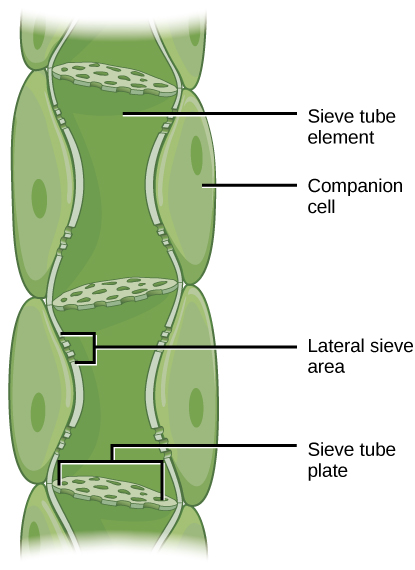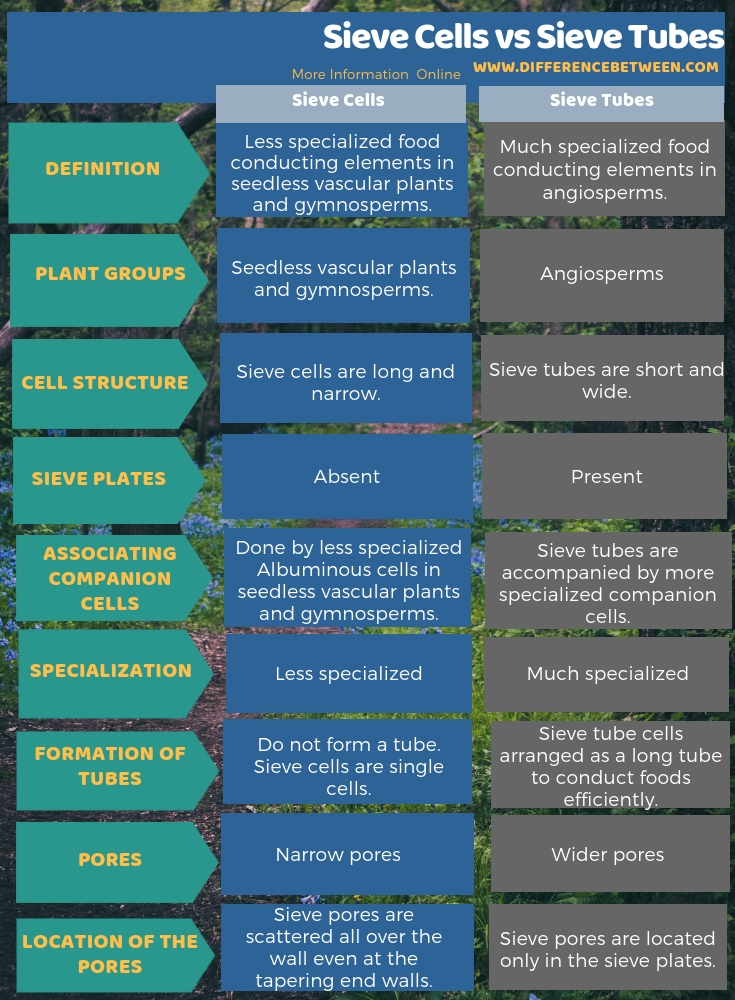The key difference between sieve cells and sieve tubes is that the sieve cells are less specialized sieve elements that lack sieve plates and present in seedless vascular plants and gymnosperms while the sieve tubes are highly specialized sieve elements that have sieve plates and present in angiosperms.
Vascular plants possess vascular bundles comprised mainly of xylem and phloem. Xylem is the vascular tissue that transports water and minerals upwards from roots to other parts of the plant. On the other hand, phloem is the vascular tissue that transports foods or nutrients from photosynthetic parts of the plant especially from leaves to other parts of the plant. Both these tissues are complex tissues composed of several different cell types. Accordingly, sieve cells and sieve tubes are two types of sieve elements present in the phloem tissue. They are the main conducting elements of the phloem.
CONTENTS
1. Overview and Key Difference
2. What are Sieve Cells
3. What are Sieve Tubes
4. Similarities Between Sieve Cells and Sieve Tubes
5. Side by Side Comparison – Sieve Cells vs Sieve Tubes in Tabular Form
6. Summary
What are Sieve Cells?
Sieve cells are a type of sieve elements present in seedless vascular plants and gymnosperms. They are less specialized cells compared to sieve tubes present in angiosperms. Sieve cells are long and narrow cells with tapering ends.
Furthermore, sieve cells lack sieve places. Moreover, they do have narrow pores all over the cell walls. Compared to sieve tubes of angiosperms, these cells are less efficient in conducting food. Also, sieve cells lack companion cells. Instead, they possess specialized parenchyma cells to do the function of companion cells. Furthermore, sieve cells remain as single cells.
What are Sieve Tubes?
Sieve tubes are well-specialized sieve elements present in angiosperms to conduct foods. These cells are short and wider.

Figure 01: Sieve Tube
Furthermore, they accompany special nucleated cells called companion cells. Sieve tubes arrange vertically and form a long tube structure in order to transport food materials efficiently. They possess sieve plates, and sieve pores are found only in the sieve plates.
What are the Similarities Between Sieve Cells and Sieve Tubes?
- Sieve cells and sieve tubes are sieve elements of the phloem tissue.
- Both function as conducting tissues.
- They transport foods throughout the plant.
- Moreover, both are living cells, but do not contain a nucleus.
- Also, these cells contain a thin primary cell wall.
- Furthermore, they lack secondary thickenings.
What is the Difference Between Sieve Cells and Sieve Tubes?
Seedless vascular plants and gymnosperms posses sieve cells as their sieve elements. But, angiosperms contain sieve tubes as their sieve elements. Moreover, sieve cells are less specialized conducting cells while sieve tubes are much specialized conducting cells. Therefore, this is the key difference between sieve cells and sieve tubes. Furthermore, sieve cells do not contain sieve plates while sieve tubes have sieve plates. Structurally, sieve cells remain as single cells while sieve tubes remain as aggregated cells forming a long tube. Thus, this is also a significant difference between sieve cells and sieve tubes.
Another major difference between sieve cells and sieve tubes is that sieve cells do not accompany companion cells while sieve tubes always accompany companion cells. Furthermore, sieve cells are long and narrow cells with tapering ends while sieve tubes are short and wide cells.
The below infographic presents more information on the difference between sieve cells and sieve tubes.

Summary – Sieve Cells vs Sieve Tubes
Sieve cells and sieve tubes are sieve elements in the phloem tissue of plants. Sieve cells are less specialized cells while sieve tubes are highly specialized cells. Furthermore, sieve cells are long and narrow cells with tapering ends while sieve tubes are short and wide cells without tapering end. Moreover, sieve cells lack sieve plates while sieve tubes have sieve plate. In sieve cells, sieve pores locate in all over the cell walls while in sieve tubes, sieve pores locate only in the sieve plates. Also, sieve cells lack companion cells while sieve cells accompany companion cells. Thus, this is the summary of the difference between sieve cells and sieve tubes.
Reference:
1. “Sieve Tube Element.” Wikipedia, Wikimedia Foundation, 14 Aug. 2018. Available here
2. Britannica, The Editors of Encyclopaedia. “Phloem.” Encyclopædia Britannica, Encyclopædia Britannica, Inc., 24 Oct. 2016. Available here
Image Courtesy:
1.”Figure 30 05 06″By CNX OpenStax , (CC BY 4.0) via Commons Wikimedia
ncG1vNJzZmivp6x7pbXFn5yrnZ6YsqOx07CcnqZemLyue8OinZ%2Bdopq7pLGMm5ytr5Wau26%2FyJ6tnmWTmrmtv4yapZ1lo56yt7GMraybnaNk